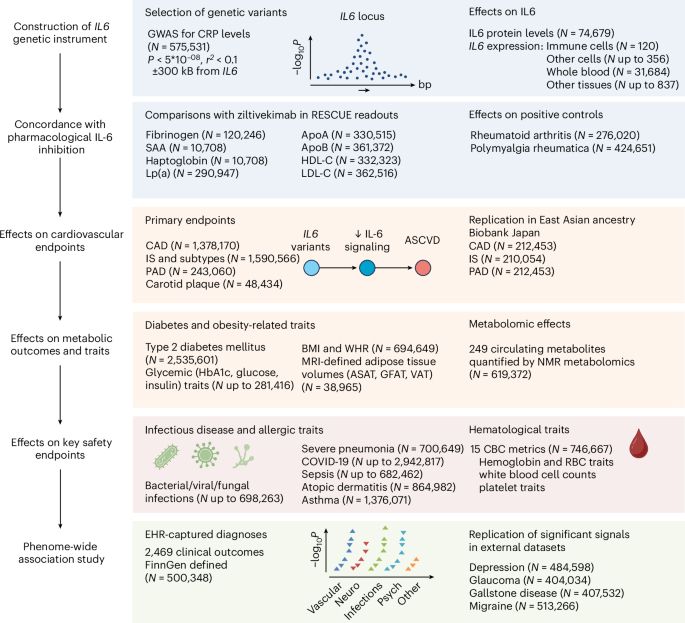
@broadinstitute.org | Writing about genetics, omics, deep phenotyping, precision medicine
https://www.deepvasc.com/

In our new @natcardiovascres.nature.com paper, we provide an end-to-end framework for genetically validating IL-6 inhibition for atherosclerotic cardiovascular disease outcomes 🧵


Some social science genetics papers are among the most interesting and methodologically rigorous I've read.
From biology to mating choices and inequalities, they deal with very fundamental concepts of what makes as humans.
My love letter to social science genetics: communities.springernature.com/posts/a-love...

Some social science genetics papers are among the most interesting and methodologically rigorous I've read.
From biology to mating choices and inequalities, they deal with very fundamental concepts of what makes as humans.

In our new @natcardiovascres.nature.com paper, we provide an end-to-end framework for genetically validating IL-6 inhibition for atherosclerotic cardiovascular disease outcomes 🧵

In our new @natcardiovascres.nature.com paper, we provide an end-to-end framework for genetically validating IL-6 inhibition for atherosclerotic cardiovascular disease outcomes 🧵
www.nature.com/articles/s44...
www.nature.com/articles/s44...

www.nature.com/articles/s44...
www.nature.com/articles/s44...

In this paper with the Tourmaline Bio team, we review how genetics pinpointed IL-6 signaling as a causal driver of athero-inflammation👇

In this paper with the Tourmaline Bio team, we review how genetics pinpointed IL-6 signaling as a causal driver of athero-inflammation👇
AtherOMICS is a biobanking project built in our lab over the past 3 years aiming to provide access to multi-omics/multi-modal data from human atherosclerotic tissue❗
Some innovations of AtherOMICS👇

AtherOMICS is a biobanking project built in our lab over the past 3 years aiming to provide access to multi-omics/multi-modal data from human atherosclerotic tissue❗
Some innovations of AtherOMICS👇
📄Single-cell transcriptome-wide Mendelian randomization and colocalization analyses uncover cell-specific mechanisms in atherosclerotic cardiovascular disease

📄Single-cell transcriptome-wide Mendelian randomization and colocalization analyses uncover cell-specific mechanisms in atherosclerotic cardiovascular disease
Yet, we lack circulating biomarkers for systemic atherosclerosis burden.
Check out our new preprint describing the development of proteomic signatures of atherosclerosis👇

Yet, we lack circulating biomarkers for systemic atherosclerosis burden.
Check out our new preprint describing the development of proteomic signatures of atherosclerosis👇
Now, it seems we could use genetic variation to predict 3D face structures with key implications for both forensic science and ethics👇

Now, it seems we could use genetic variation to predict 3D face structures with key implications for both forensic science and ethics👇
Is it just me, or is it odd that the main analysis used population controls (broad definition) instead of individuals with SARS-CoV-2 infection without long COVID (strict definition)?

Is it just me, or is it odd that the main analysis used population controls (broad definition) instead of individuals with SARS-CoV-2 infection without long COVID (strict definition)?
Pacibekitug (Tourmaline Bio), an s.c. anti-IL6 mAb showed hsCRP reductions in patients with stage 3/4 CKD and hsCRP>2 mg/dl in phase 2.
Big advantage the potential for quarterly dosing💉

Pacibekitug (Tourmaline Bio), an s.c. anti-IL6 mAb showed hsCRP reductions in patients with stage 3/4 CKD and hsCRP>2 mg/dl in phase 2.
Big advantage the potential for quarterly dosing💉

Human genetics has been key to shaping this field with discoveries of loss-of-function variants in APOC3, ANGPTL3, ANGPTL4 having directly triggered clinical development 🧬-->💊

Human genetics has been key to shaping this field with discoveries of loss-of-function variants in APOC3, ANGPTL3, ANGPTL4 having directly triggered clinical development 🧬-->💊
1⃣ Circadian gene expression regulation by rhythmic genetic variants
🧵[1/8]

1⃣ Circadian gene expression regulation by rhythmic genetic variants
🧵[1/8]
Available platforms offer increasingly broader coverage, but often yield different results for the same proteins.
This preprint compares quantifications of mass spectrometry & Olink in the same samples👇

Available platforms offer increasingly broader coverage, but often yield different results for the same proteins.
This preprint compares quantifications of mass spectrometry & Olink in the same samples👇
Although assumed to influence expression, pinpointing the causal gene isn't easy.
Two ways include:
1⃣eQTL mapping in relevant tissues/cells
2⃣in vitro CRISPRi screens
This preprint compares the two👇

Although assumed to influence expression, pinpointing the causal gene isn't easy.
Two ways include:
1⃣eQTL mapping in relevant tissues/cells
2⃣in vitro CRISPRi screens
This preprint compares the two👇
1⃣ Tissue-specific atlas of protein co-abundance
[1/6] 🧵

1⃣ Tissue-specific atlas of protein co-abundance
[1/6] 🧵
👉Lanyue Zhang, awarded a Young Investigator Fellowship, on proteomic signatures of atherosclerosis at the EAS Congress in Glasgow
👉Anushree Ray, recipient of a Travel Award, on single-cell drivers of atherosclerosis at the CHARGE meeting in Maryland

👉Lanyue Zhang, awarded a Young Investigator Fellowship, on proteomic signatures of atherosclerosis at the EAS Congress in Glasgow
👉Anushree Ray, recipient of a Travel Award, on single-cell drivers of atherosclerosis at the CHARGE meeting in Maryland
Slight differences in inclusion criteria (e.g. long-term vs. any use), but both generally point to a benefit.

Slight differences in inclusion criteria (e.g. long-term vs. any use), but both generally point to a benefit.
This map shows the genomic ancestry of individuals recruited to All of Us across US states.
While still predominantly European, it is possibly one of the most diverse biomedical datasets out there.

This map shows the genomic ancestry of individuals recruited to All of Us across US states.
While still predominantly European, it is possibly one of the most diverse biomedical datasets out there.
It identifies tertiary lymphoid organs within plaques and links them to symptomatic cerebrovascular disease (stroke/TIA) 🧠

It identifies tertiary lymphoid organs within plaques and links them to symptomatic cerebrovascular disease (stroke/TIA) 🧠
A new approach introduces a framework for MR analyses that captures trait trajectories over time📈

A new approach introduces a framework for MR analyses that captures trait trajectories over time📈

